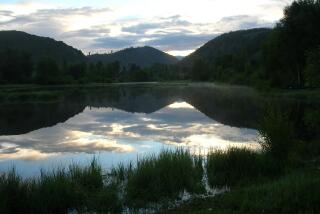Camp Meeting Calls Islanders Home for Prayer
- Share via
EWELL, Md. — On an island in the Chesapeake Bay that is unreachable by car, nothing takes away from the praying.
Worshipers tap their feet along with the Southern gospel performers, and they murmur “Amen” when the gentle preaching pauses. But they are surrounded by solitude on Smith Island.
Every summer for 116 years, churchgoers have walked from their homes or caught a boat “over home” to attend the annual camp meeting here.
It began as a way for Methodists to convert their neighbors, but has evolved over the last century into a homecoming for old crabbers and the families that moved away from Smith Island to find work or a less-isolated lifestyle.
“I live in Easton, but I’m a Smith Islander. I’ve only lived on the mainland 20 years,” said Dixie Larrimore, 64. She describes herself the way many islanders do: “I have mud between my toes.”
Weeklong camp meetings are a tradition in several parts of the country, especially the mid-Atlantic region, where Methodist retreats are among the best-known.
The meetings started around 1800, but most faded away in the early 1900s, when America became more mobile, said Philip Lawton, a historian of Methodism who volunteers at Barratt’s Chapel Museum in Frederica, Del. People began traveling to resorts instead of religious retreats for vacation.
On Smith Island -- population 295 -- it takes a special commitment for nonresidents to attend the camp meeting, and that may be part of what has kept the tradition alive. First, there is the boat trip over -- 12 miles from the southern tip of the Eastern Shore. Then, there is the overnight stay -- usually at a relative’s house or at one of two small inns.
For nonislanders, it’s a real break from the routine. For people who live here, it’s easier to stay for the camp meeting than to go somewhere else.
The setting on the tiny island makes the meetings quieter, more hallowed.
“There’s no Hollywood to it,” said Steve Eades, innkeeper, charter boat captain and general store owner on the island. “That helps with the religious part of it. Once you’re there, there are no distractions.”
On the first day of this summer’s camp meeting, July 27, about 130 people gathered inside a low, dark tabernacle that is opened yearly only for this occasion. The day’s events were much like those on the days that followed: testimony meeting, morning worship, song service and a nightly service.
Worshipers entered quietly, reaching to catch the wooden door before a rusty spring slammed it shut. They talked in low voices inside.
Congregants sat in wooden pews and rested their Sunday shoes on a dirt floor covered with sawdust and cedar shavings. The week’s events opened with a prayer, thanking God for “the crabs, the fish and the oysters.”
More to Read
Sign up for Essential California
The most important California stories and recommendations in your inbox every morning.
You may occasionally receive promotional content from the Los Angeles Times.













